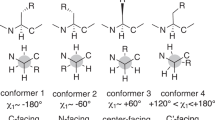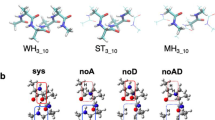Abstract
In this paper, B3LYP and MP2 methods are used to investigate the binding energy of seventeen antiparallel and parallel β-sheet models. The results indicate that the binding energy obtained from B3LYP calculations is weaker than that obtained from MP2 calculations but the relative binding energy yielded by B3LYP is almost the same as that by MP2. For the antiparallel β-sheets in which two N-H⋯O=C hydrogen bonds can form either a large hydrogen-bonded ring or a small hydrogen-bonded ring, the binding energy increases obviously when one large ring unit is added, whereas it only changes slightly when one small ring unit is added because of the secondary electrostatic repulsive interaction existing in the small ring unit which is estimated to be about 20 kJ/mol. For the parallel β-sheet models, the binding energy increases almost exactly linearly with the increase of the chain length.
Similar content being viewed by others
References
Garcia-Viloca M, Gao J, Karplus M, Truhlar D G. How enzymes works: Analysis by modern rate theory and computer simulations. Science, 2004, 303: 186–195
Zhao Y L, Wu Y D. A theoretical study of β-sheet models: Is the formation of hydrogen-bond networks cooperative? J Am Chem Soc, 2002, 124: 1570–1571
Viswanathan R, Asensio A, Dannenberg J J. Cooperative hydrogen- bonding in models of antiparallel β-sheets. J Phys Chem A, 2004, 108: 9205–9212
Chen Y F, Dannenberg J J. Cooperative 4-pyridone H-bonds with extraordinary stability. A DFT molecular orbital study. J Am Chem Soc, 2006, 128: 8100–8101
Scheiner S. Contributions of NH⋯O and CH⋯O hydrogen bonds to the stability of β-sheets in proteins. J Phys Chem B, 2006, 110: 18670–18679
Levin S, Nowick J S. An artificial β-sheet that dimerizes through parallel β-sheet interactions. J Am Chem Soc, 2007, 129: 13043–13048
Wang Z X, Wu C, Lei H X, Duan Y. Accurate ab initio study on the hydrogen-bond pairs in protein secondary structures. J Chem Theory Comput, 2007, 3: 1527–1537
Sipe J D. Amyloidosis. Annu Rev Biochem, 1992, 61: 947–975
Zhou J M. Protein misfolding and disease. Prog Biochem Biophys, 2000, 27: 579–584
Prusiner S B. Prion disease and the BSE crisis. Science, 1997, 278: 245–251
Collinge J. Prion disease of humans and animals: Their causes and molecular bairs. Annu Rev Neurosci, 2001, 24: 519–550
Petkova T A, Ishii Y, Balbach J J, Antzutkin O N, Leapman R D, Delaglio F, Tycko R. A structural model for Alaheimers’s β-armyoid fibrils based on experimental constrains from solid state NMR. Proc Natl Acad Sic USA, 2002, 99: 16742–16747
Wu Y D, Zhao Y L. A theoretical study on the origin of cooperativity in the formation of 310- and α-helices. J Am Chem Soc, 2001, 123: 5313–5319
Lin J Q, Luo S W, Wu Y D. Theoretical study of sheets formed by β-peptides. J Comput Chem, 2002, 23: 1551–1558
Jiang L, Lai L H. CH⋯O hydrogen bonds at protein-protein interfaces. J Biol Chem, 2002, 277: 37732–37740
Simon S, Duran M, Dannenberg J J. How does basis set superposition error change the potential surfaces for hydrogen-bonded dimers? J Chem Phys, 1996, 105: 11024–11031
Boys S F, Bernardi F. Calculations of small molecular interactions by differences of separate total energy. Some procedures with reduced errors. Mol Phys, 1970, 19: 553–556
Frisch M J, Trucks G W, Schlegel H B, Scuseria G E, Robb M A, Cheeseman J R, Zakrzewski V G, Montgomery J A Jr, Stratmann R E, Burant J C, Dapprich S, Millam J M, Daniels A D, Kudin K N, Strain M C, Farkas O, Tomasi J, Barone V, Cossi M, Cammi R, Mennucci B, Pomelli C, Adamo C, Clifford S, Ochterski J, Petersson G A, Ayala P Y, Cui Q, Morokuma K, Malick D K, Rabuck A D, Raghavachari K, Foresman J B, Cioslowski J, Ortiz J V, Baboul A D, Stefanov B B, Liu G, Liashenko A, Piskorz P, Komaromi I, Gomperts R, Martin R L, Fox D J, Keith T, Al-Laham M A, Peng C Y, Nanayakkara A, Gonzalez C, Challacombe M, Gill P M W, Johnson B, Chem W, Wong M W, Andres J L, Gonzalez C, Head-Gordon M, Replogle E S, Pople J A. Gaussian 03; Pittsburgh: Gaussian Inc, 2003
Chin W, Piuzzi F, Dimicoli I, Mons M. Probing the competition between secondary structures and local preferences in gas phase isolated peptide backbones. Phys Chem Chem Phys, 2006, 8: 1033–1048
Author information
Authors and Affiliations
Corresponding author
Additional information
Supported by the National Natural Science Foundation of China (Grant Nos. 20573049 & 20633050) and the Research Fund of the Department of Education of Liaoning Province (Grant Nos. 2007T091 & 20060469)
Rights and permissions
About this article
Cite this article
Sun, C., Wang, C. Theoretical studies on the binding energy of β-sheet models. Sci. China Ser. B-Chem. 52, 2243–2248 (2009). https://doi.org/10.1007/s11426-009-0122-z
Received:
Accepted:
Published:
Issue Date:
DOI: https://doi.org/10.1007/s11426-009-0122-z




